Editor of this issue: Antanas Klimas
Copyright © 1998 LITUANUS Foundation, Inc.

|
LITUANUS
LITHUANIAN QUARTERLY JOURNAL OF ARTS AND SCIENCES
Volume 44, No.1 - Spring 1998
Editor of this issue: Antanas Klimas ISSN 0024-5089
Copyright © 1998 LITUANUS Foundation, Inc. |

|
BOOKPLATES
COMMEMORATING 450TH ANNIVERSARY OF THE PUBLICATION OF THE FIRST LITHUANIAN BOOK
GIEDRĖ JANKEVIČIŪTĖ
The publication of the first Lithuanian book is regarded to be the most significant event in the history of our nation.
Four hundred fifty years ago, the first Lithuanian book - a catechism compiled by Martynas Mažvydas -was published in the Prussian dukedom. The significance of this small book by a Protestant priest to the development of our culture is still to be determined. Events dedicated to the anniversary year of the first Lithuanian book offer a lot of opportunities for commemorative activities. An international bookplate competition organized by the Ministry of Culture of the Republic of Lithuania, Vilnius Academy of Arts and the Lithuanian Artists' Union, is one of them.
Lithuanian artists and students of Vilnius Academy of Arts, M.K. Čiurlionis and Kaunas Gymnasiums of Arts were the first to respond to the invitation. For the students, it was a serious task that prompted them to reflect on the specificity of a bookplate and the history of Lithuanian culture. One would like to expect that participation in the competition would help some of them join the ranks of our bookplate artists and take a deeper interest in the Lithuanian past and personalities whose names can be brought back to the present by works of history of art.
Foreign graphic artists also showed an interest in the anniversary of the first Lithuanian book. Works were sent in by Belgian, Czech, Estonian, Italian, Latvian, Polish, French, Russian, Ukrainian, Hungarian, and German artists. Such geographic diversity may seem symbolic as one reflects upon the occasion for the competition. Bookplates that easily travel from one country to another spread like a growing quilt, extending threads linking different cultures. This aspect of the competition is illustrated by Italian Paola Ginepri's work which shows an open book gliding as a bird above the map of the Baltic countries.
What is connected more closely than these? Which type of artists can grasp the essence and the meaning of a book better than a bookplate artist? The background and the fate of the first book in the language of a small nation should intrigue artists, stimulate the imagination and be depicted into expressive and meaningful images, bringing the 16th century event under consideration closer to the present. For the majority of the participants in the competition, however, the organizer's invitation to create bookplates related to the present of Lithuanian culture was more acceptable. Many authors devoted their works to Vytautas Landsbergis, investigators of ancient books Dominykas Urbas and Vytautas Bogušis. Bookplates by Augustas Virgilijus Burba, an artist from Klaipėda, dedicated to Enzo Pella and Guido Michelini, reflect modern cultural links between Lithuania and Italy. Viktorija Daniliauskaitė's bookplates are probably most expressive among the works of this kind. In elegant silver-gray and black compositions, she paraphrases, in a masterful fashion, characteristic motifs from the works of recently-deceased Lithuanian book graphic artist Rimtautas Gibavičius, Vincas Kisarauskas and Algirdas Steponavičius, inserting these works into the context of the history of the Lithuanian book.
Only a few authors were prompted by the tiny space of a bookplate to condense the thought and to express it in a laconic icon-type image. Being a sculptor, Benas Narbutas may have drawn on his experience to depict the theme as a graceful ornamented chapel of books. The way of stylization chosen by him is, however, a bit too refined, if one bears in mind the nature of the publication being commemorated. Two small-sized, modest and precise aquatints by Rasa Pryšmontienė from Šiauliai represent a really impressive and modern monument to the press and the book.
Many of the participants in the competition sought specific references to the events surrounding the book being commemorated and its epoch. In the exhibition, we see several portraits of Martynas Mažvydas' precursors, such as professors of Karaliaučius University Abraomas Kulvietis and Stanislovas Rapolionis. We also see scenes of a Renaissance printing-house; unfortunately there's no reference to the Hans Weinreich printing-house, where Mažvydas' books saw the light of day, and where Lithuanian books were also printed.
Some artists tried to portray cultural symbols related to the anniversary without going into the literature historians. Thus, in many of the bookplates presented for the competition, Karaliaučius University is overshadowed by the buildings of Vilnius University or, more often, by the Baroque towers of the Vilnius churches.
The attractiveness of the Baroque forms and iconography for the Lithuanian graphic artists is confirmed also by the inclination to picture decorative figures of angels. That's both nice and symbolic. One would just wish to advise Ramūnas Krupauskas, who has made an angel with a book descend from the sky to a monk standing in a pouring rain, to take a deeper interest in St.. Matthew's iconography.
Some bookplates were created with an historical orientation, and Roberta Vaigeltaitė's attitude, which is close to the ideas of the Enlightenment, seems attractive. Her bookplate - with a panorama of Karaliaučius University and texts about the wealth of the university library is one of those few that represent an artistic interpretation of the place, time, and environment of the birth of the first Lithuanian book.
The metaphor of a tree growing out of a book probably confirms the fact that Lithuanians frequently learn more from nature rather than from history.
The works by Lithuanian authors and by artists from other countries demonstrated our attachment to the artistic traditions that have been formed in the 20th century. In the Lithuanian bookplates, we do not see paraphrases of the old books' elements, and there are no references to the world's heritage of the book art. This limitation is particularly obvious in the bookplate by the Czech Vladimir Hadomsky. His bookplate is surprising; it provides a wide cultural context - the attributes of a historical book (initials, miniatures, and paraphrases of surrealist graphic works and photography). In one of his bookplates, he depicts the meeting of Martynas Mažvydas and his patron the Prussian duke Albrecht, Vladímir Hadomský, who may even have been the customer of the first Lithuanian book, presents an example of a historical composition with a plot on the subject of the first Lithuanian book. By doing this, he arouses controversial thoughts about the means of expression used, his collection of bookplates attracts attention with its vivid and dynamic dialogue on the culture of the times and its various layers.
Thus, the value of the competition is not confined to its direct result - the bookplates commemorating the fact of the appearance of the first Lithuanian book and the significance of this event. The works of the participants in the competition represent material for reflection on the relationship between modern art and the heritage of the past and, more broadly, on how we choose to interpret history.
Exhibitions of Mažvydas' bookplates were held in Lithuania in 1997 and then traveled to the United States and elsewhere..
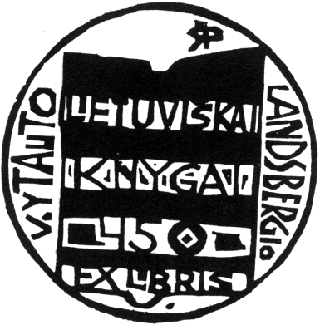
Povilas Šiaučiūnas
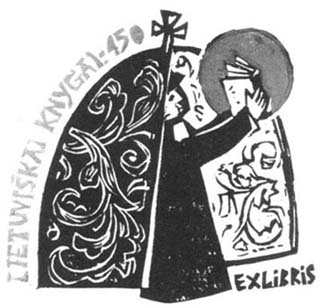
Valerijonas Jucys
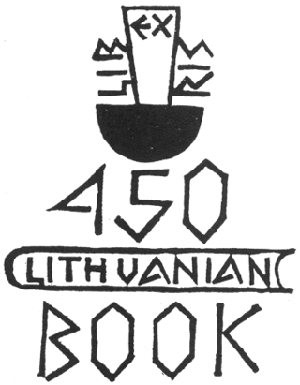
Jindrich Novak
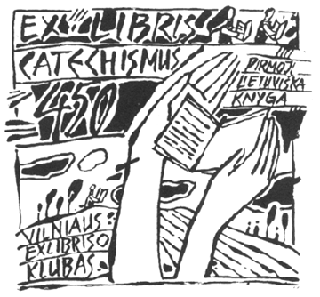
Adomas Matuliauskas
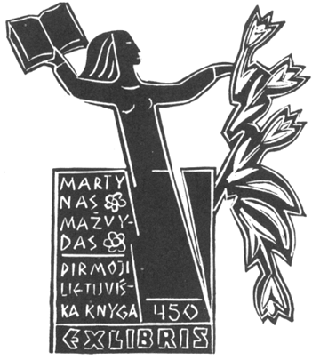
Algirdas Indrašius
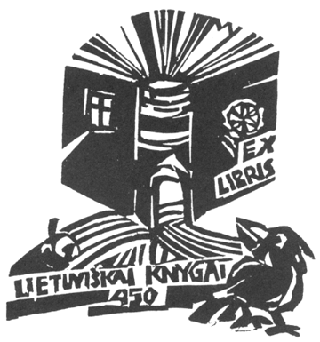
Bronislava Pranckevičiūtė

Inga Ševčenkaitė
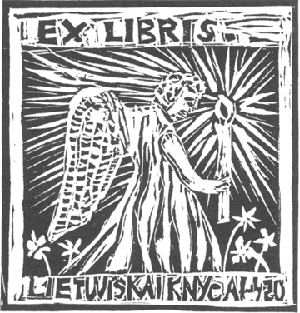
Tomas Kasparavičius
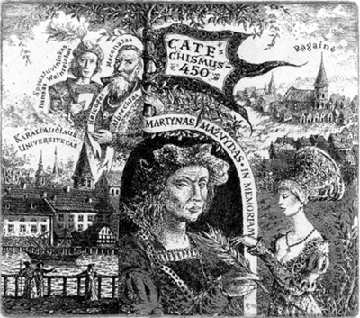
Marius Liugaila